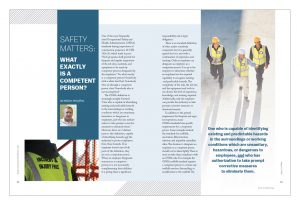Safety Matters: What Exactly Is a Competent Person?
One of the most frequently cited Occupational Safety and Health Administration (OSHA) standards during inspections of construction projects is 29 CFR 1926.20, which reads in part: “Such programs shall provide for frequent and regular inspections of the job sites, materials, and equipment to be made by competent persons designated by the employers.” So, what exactly is a competent person? Somebody with a white hard hat? Somebody who sat through a competent person class? Somebody who is not incompetent?
The OSHA definition is seemingly straight-forward: “One who is capable of identifying existing and predictable hazards in the surroundings or working conditions which are unsanitary, hazardous, or dangerous to employees, and who has authorization to take prompt corrective measures to eliminate them.” However, there are 2 distinct parts to this definition: capable of identifying hazards and the authority to protect employees from those hazards. If an employee doesn’t meet both parts of the definition, they are not a competent person. When an employer designates someone as a competent person, it is not necessarily complimenting their abilities; it is giving them a significant responsibility and a legal obligation.
There is no standard definition of what makes somebody competent, but it is generally agreed that it is met with a combination of experience and training. Only an employer can designate an employee as a competent person. It is up to the employer to determine whether an employee has the required capability to recognize existing and predictable hazards. The complexity of the task, the job site, and the equipment and tools in use dictate the level of experience, knowledge, and training required. Additionally, only the employer can provide the authority to take prompt corrective measures to eliminate hazards.
In addition to the general requirement for frequent and regular inspections, many OSHA standards have specific requirements for a competent person. Some examples include the standards for scaffolds, excavation, fall protection, asbestos, and respirable crystalline silica. The decision to designate an employee as a competent person should not be taken lightly. There is more at stake than compliance with an OSHA rule. For example, the OSHA scaffold standard requires a competent person to oversee any scaffold erection, dismantling, or modification to the scaffold. The competent person also must inspect scaffolds before each work shift. The safety of many workers may depend on the competent worker’s capability.
Another common misconception is that “one size fits all” when it comes to the requirements for a competent person. A single employer may need several competent persons on one project—all with different areas of expertise. For example, a project involving insulation work in a confined space may need a competent person who is familiar with the insulation work, and another having specialized knowledge of the unique hazards of working in confined spaces. If asbestos-containing materials were going to be disturbed, this may require yet another competent person.
So how can you tell if your competent person really is competent? The best way to demonstrate the capability of a competent person is through documented safety inspections. Inspection findings show the ability to identify hazards and demonstrate the authority to have them corrected. The reason this rule is consistently among OSHA’s Top 10 list is that the presence of hazards on a job site is a sign that the competent person either doesn’t have the requisite knowledge or lacks the authority to have the hazard corrected. So, choose your competent persons wisely and make sure they have the training, experience, and authority to carry out their duties effectively. Competent persons are where the rubber meets the road, so if you want to improve your safety performance, then you should focus on your competent persons.
Copyright Statement
This article was published in the August 2018 issue of Insulation Outlook magazine. Copyright © 2018 National Insulation Association. All rights reserved. The contents of this website and Insulation Outlook magazine may not be reproduced in any means, in whole or in part, without the prior written permission of the publisher and NIA. Any unauthorized duplication is strictly prohibited and would violate NIA’s copyright and may violate other copyright agreements that NIA has with authors and partners. Contact publisher@insulation.org to reprint or reproduce this content.

